Abstract
The chronic exposure of large segments of the population to disinfected drinking water has necessitated an evaluation of the health effects of the by-products of the chlorination process. This paper reviews the available information concerning the reproductive consequences associated with exposure to disinfection by-products. Four groups of compounds are discussed: the trihalomethanes, in particular chloroform; the chlorinated phenols; chlorinated humic substances; and the haloacetonitriles. In the pregnant female, chloroform and the 2- and 2,4-chlorophenols produced low levels of embryo- and fetotoxicity. Chloroform induced terata when administered by inhalation. The chlorinated humic substances and 2,4,6-trichlorophenol were without significant reproductive effects. The haloacetonitriles showed in utero toxicity, becoming more severe with increasing halogen substitution.
Full text
PDF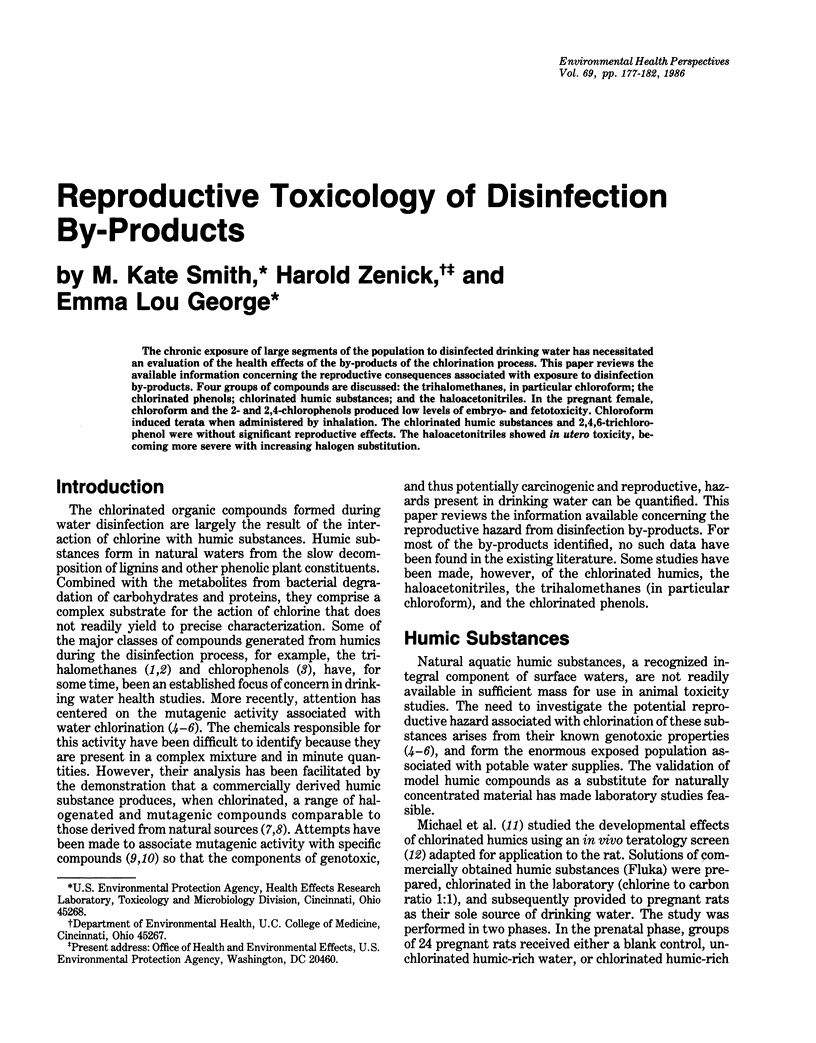
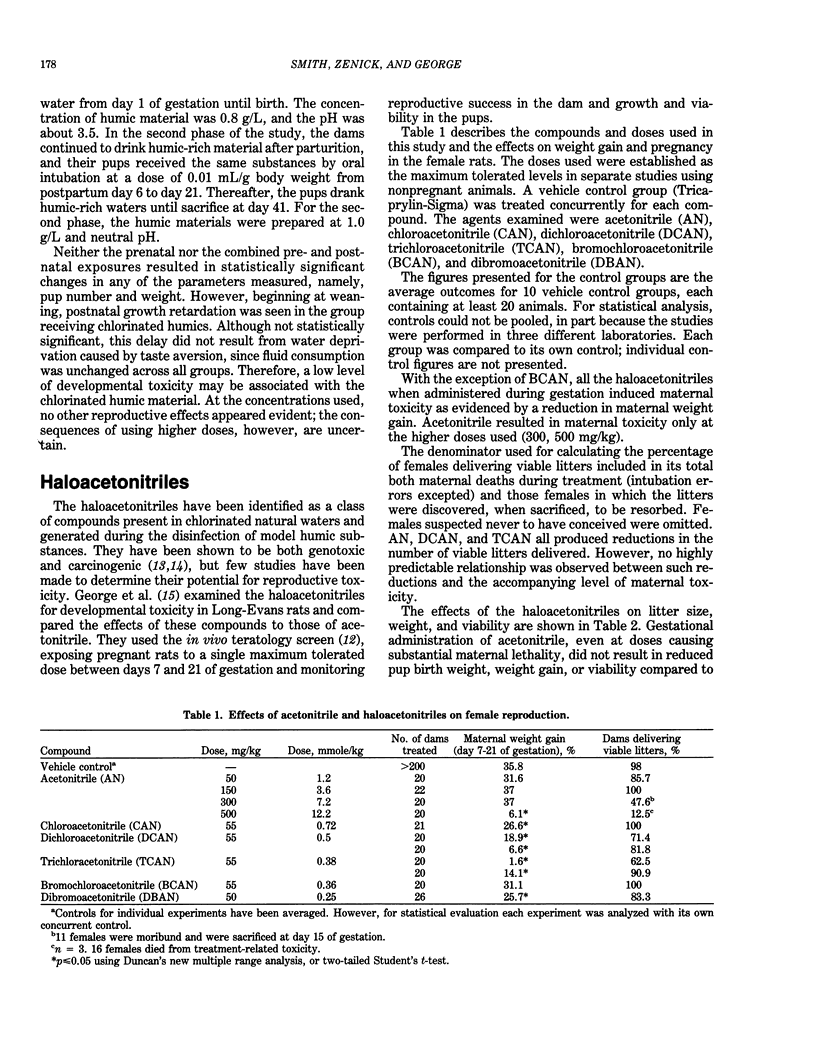
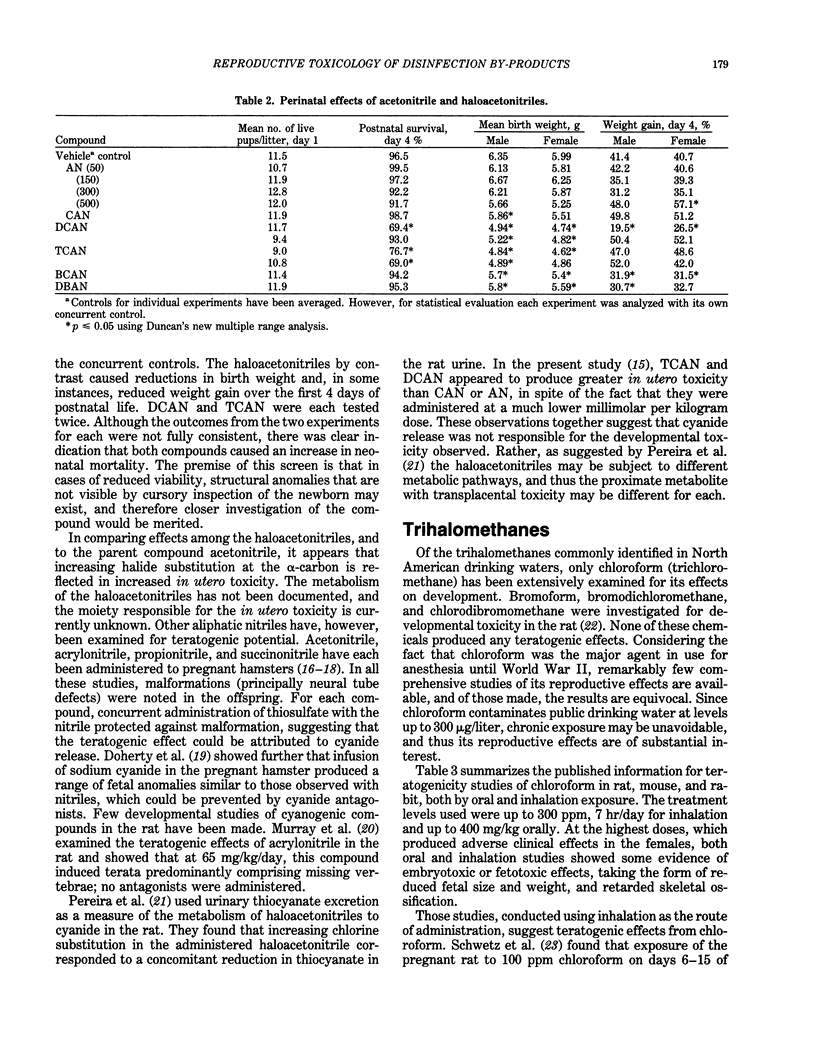
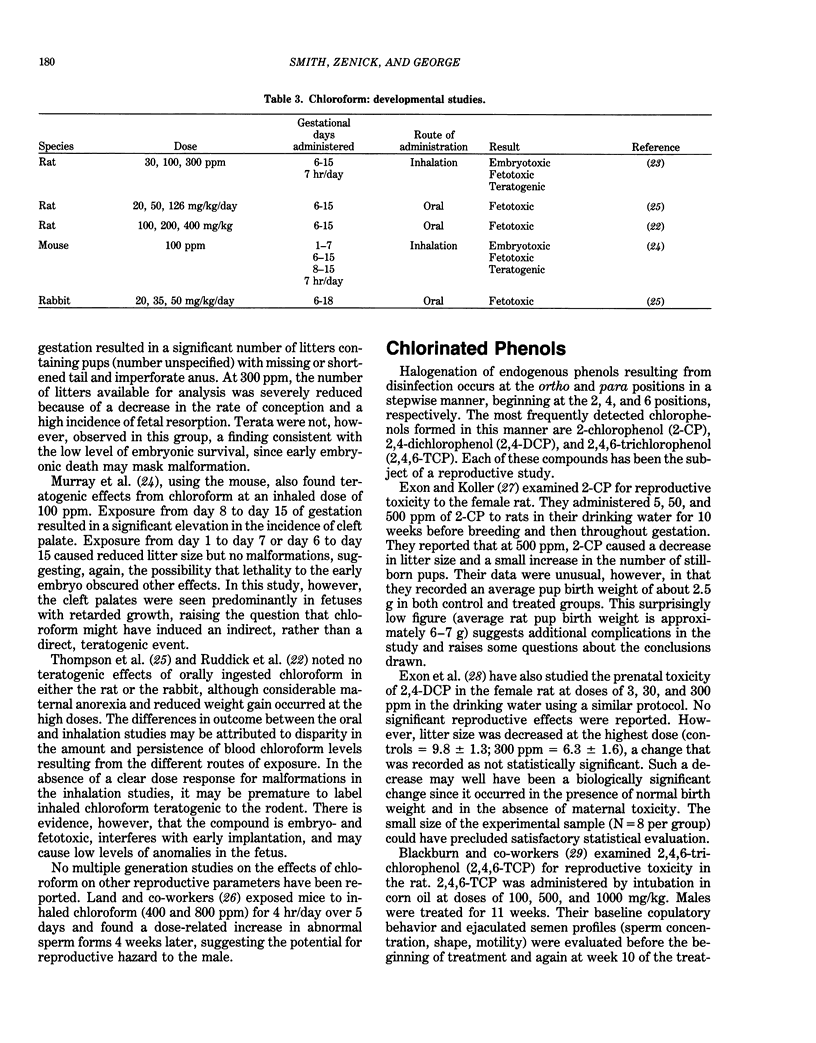
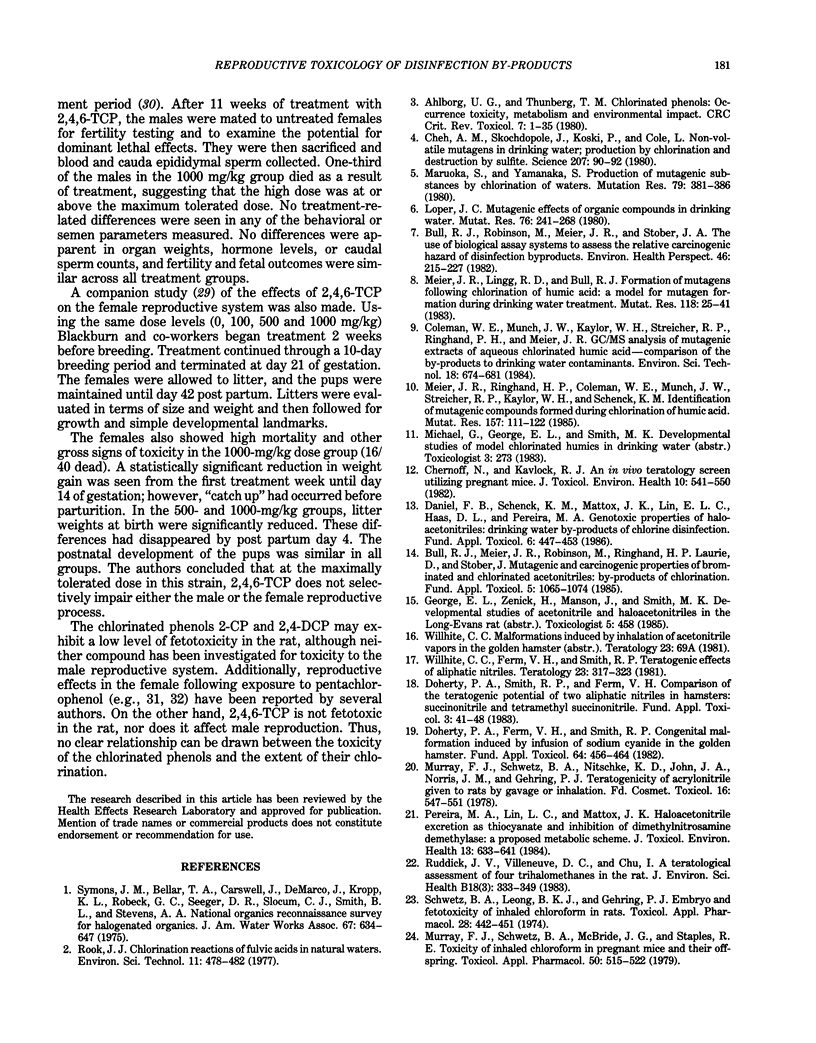

Selected References
These references are in PubMed. This may not be the complete list of references from this article.
- Ahlborg U. G., Thunberg T. M. Chlorinated phenols: occurrence, toxicity, metabolism, and environmental impact. Crit Rev Toxicol. 1980 Jul;7(1):1–35. doi: 10.3109/10408448009017934. [DOI] [PubMed] [Google Scholar]
- Blackburn K., Zenick H., Hope E., Manson J. M., George E. L., Smith M. K. Evaluation of the reproductive toxicology of 2,4,6-trichlorophenol in male and female rats. Fundam Appl Toxicol. 1986 Feb;6(2):233–239. doi: 10.1016/0272-0590(86)90236-8. [DOI] [PubMed] [Google Scholar]
- Bull R. J., Meier J. R., Robinson M., Ringhand H. P., Laurie R. D., Stober J. A. Evaluation of mutagenic and carcinogenic properties of brominated and chlorinated acetonitriles: by-products of chlorination. Fundam Appl Toxicol. 1985 Dec;5(6 Pt 1):1065–1074. doi: 10.1016/0272-0590(85)90142-3. [DOI] [PubMed] [Google Scholar]
- Bull R. J., Robinson M., Meier J. R., Stober J. Use of biological assay systems to assess the relative carcinogenic hazards of disinfection by-products. Environ Health Perspect. 1982 Dec;46:215–227. doi: 10.1289/ehp.8246215. [DOI] [PMC free article] [PubMed] [Google Scholar]
- Cheh A. M., Skochdopole J., Koski P., Cole L. Nonvolatile mutagens in drinking water: production by chlorination and destruction by sulfite. Science. 1980 Jan 4;207(4426):90–92. doi: 10.1126/science.6985746. [DOI] [PubMed] [Google Scholar]
- Chernoff N., Kavlock R. J. An in vivo teratology screen utilizing pregnant mice. J Toxicol Environ Health. 1982 Oct-Nov;10(4-5):541–550. doi: 10.1080/15287398209530275. [DOI] [PubMed] [Google Scholar]
- Daniel F. B., Schenck K. M., Mattox J. K., Lin E. L., Haas D. L., Pereira M. A. Genotoxic properties of haloacetonitriles: drinking water by-products of chlorine disinfection. Fundam Appl Toxicol. 1986 Apr;6(3):447–453. doi: 10.1016/0272-0590(86)90218-6. [DOI] [PubMed] [Google Scholar]
- Doherty P. A., Ferm V. H., Smith R. P. Congenital malformations induced by infusion of sodium cyanide in the golden hamster. Toxicol Appl Pharmacol. 1982 Jul;64(3):456–464. doi: 10.1016/0041-008x(82)90242-3. [DOI] [PubMed] [Google Scholar]
- Doherty P. A., Smith R. P., Ferm V. H. Comparison of the teratogenic potential of two aliphatic nitriles in hamsters: succinonitrile and tetramethylsuccinonitrile. Fundam Appl Toxicol. 1983 Jan-Feb;3(1):41–48. doi: 10.1016/s0272-0590(83)80171-7. [DOI] [PubMed] [Google Scholar]
- Exon J. H., Henningsen G. M., Osborne C. A., Koller L. D. Toxicologic, pathologic, and immunotoxic effects of 2,4-dichlorophenol in rats. J Toxicol Environ Health. 1984;14(5-6):723–730. doi: 10.1080/15287398409530621. [DOI] [PubMed] [Google Scholar]
- Exon J. H., Koller L. D. Effects of transplacental exposure to chlorinated phenols. Environ Health Perspect. 1982 Dec;46:137–140. doi: 10.1289/ehp.8246137. [DOI] [PMC free article] [PubMed] [Google Scholar]
- Land P. C., Owen E. L., Linde H. W. Morphologic changes in mouse spermatozoa after exposure to inhalational anesthetics during early spermatogenesis. Anesthesiology. 1981 Jan;54(1):53–56. doi: 10.1097/00000542-198101000-00010. [DOI] [PubMed] [Google Scholar]
- Loper J. C. Mutagenic effects of organic compounds in drinking water. Mutat Res. 1980 Nov;76(3):241–268. doi: 10.1016/0165-1110(80)90019-6. [DOI] [PubMed] [Google Scholar]
- Maruoka S., Yamanaka S. Production of mutagenic substances by chlorination of waters. Mutat Res. 1980 Dec;79(4):381–386. doi: 10.1016/0165-1218(80)90163-9. [DOI] [PubMed] [Google Scholar]
- Meier J. R., Lingg R. D., Bull R. J. Formation of mutagens following chlorination of humic acid. A model for mutagen formation during drinking water treatment. Mutat Res. 1983 Jul;118(1-2):25–41. doi: 10.1016/0165-1218(83)90113-1. [DOI] [PubMed] [Google Scholar]
- Meier J. R., Ringhand H. P., Coleman W. E., Munch J. W., Streicher R. P., Kaylor W. H., Schenck K. M. Identification of mutagenic compounds formed during chlorination of humic acid. Mutat Res. 1985 Aug-Sep;157(2-3):111–122. doi: 10.1016/0165-1218(85)90105-3. [DOI] [PubMed] [Google Scholar]
- Murray F. J., Schwetz B. A., McBride J. G., Staples R. E. Toxicity of inhaled chloroform in pregnant mice and their offspring. Toxicol Appl Pharmacol. 1979 Sep 30;50(3):515–522. doi: 10.1016/0041-008x(79)90406-x. [DOI] [PubMed] [Google Scholar]
- Murray F. J., Schwetz B. A., Nitschke K. D., John J. A., Norris J. M., Gehring P. J. Teratogenicity of acrylonitrile given to rats by gavage or by inhalation. Food Cosmet Toxicol. 1978 Dec;16(6):547–551. doi: 10.1016/s0015-6264(78)80222-3. [DOI] [PubMed] [Google Scholar]
- Pereira M. A., Lin L. H., Mattox J. K. Haloacetonitrile excretion as thiocyanate and inhibition of dimethylnitrosamine demethylase: a proposed metabolic scheme. J Toxicol Environ Health. 1984;13(4-6):633–641. doi: 10.1080/15287398409530527. [DOI] [PubMed] [Google Scholar]
- Schwetz B. A., Leong B. K., Gehring P. J. Embryo- and fetotoxicity of inhaled chloroform in rats. Toxicol Appl Pharmacol. 1974 Jun;28(3):442–451. doi: 10.1016/0041-008x(74)90229-4. [DOI] [PubMed] [Google Scholar]
- Thompson D. J., Warner S. D., Robinson V. B. Teratology studies on orally administered chloroform in the rat and rabbit. Toxicol Appl Pharmacol. 1974 Sep;29(3):348–357. doi: 10.1016/0041-008x(74)90107-0. [DOI] [PubMed] [Google Scholar]
- Willhite C. C., Ferm V. H., Smith R. P. Teratogenic effects of aliphatic nitriles. Teratology. 1981 Jun;23(3):317–323. doi: 10.1002/tera.1420230306. [DOI] [PubMed] [Google Scholar]
- Zenick H., Blackburn K., Hope E., Oudiz D., Goeden H. Evaluating male reproductive toxicity in rodents: a new animal model. Teratog Carcinog Mutagen. 1984;4(1):109–128. doi: 10.1002/tcm.1770040110. [DOI] [PubMed] [Google Scholar]


